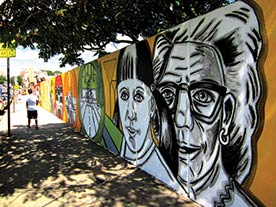Draconian cutbacks in health, welfare and housing services, attacks on the civil rights of people of color, gays and lesbians, immigrants, and the reproductive rights of all women has solidified one rallying cry among social justice organizers – “Fight the Right.”
But who makes up “the Right” and how do you fight them? Many organizations are grappling with this question as they face an array of “wedge” issues beyond the scope of their traditional focus, often driven, and decided, by seemingly faraway forces.
A good case in point is the anti-affirmative action “California Civil Rights Initiative” (CCRI), which serves numerous right-wing purposes: it drastically cuts the educational and economic opportunities available to people of color and threatens the setting of contract goals for minority contracting. While most of the attention is focused on racial issues, the proposition also handily strikes a blow at the employment opportunities available to women of all races. As an example of the Right’s “divide and conquer” strategy, the initiative divides relatively successful members of communities of color from those less economically successful, cleaves some Asian communities from other people of color, and splits progressive Democrats of all colors from centrist Democrats.
How can community organizations use this threat as an opportunity to build their constituent base and win concrete gains? One organization pushing the envelope on this question is California-based Youth for Justice (YFJ), a new organizing project of the Center for Third World Organizing (CTWO). Organizers Acebo and Abdi Soltani, who had previously worked with the Student Environmental Action Coalition, a national network of campus-based activist organizations, saw the potential to take advantage of the new wave in campus and youth organizing and build connections between community-based youth formations and campus organizations.
After deciding to work with this constituency, the organizing team had to figure out ways to capture the interest of young people with a communications medium common to youth culture. After unsuccessfully experimenting with leaflets and fact sheets, the YFJ organizing team designed a series of trading cards with catchy graphics and simple facts about the Right. The card on Howard Ahmanson tells who he is, what he spends his money on, and how he is connected to Home Savings. “The cards have been a great way to expose youth to who the players are, what their agenda is, and how they’re organized. You can get your hands on it, you can put it in your pocket. It’s not a dissertation, and it gets the message across,” said Soltani.
Because of Ahmanson’s financial ties, YFJ has been holding actions at local branches of Home Savings. “We’re targeting an institution that does business in our community. We can hold them accountable,” explained Soltani. The youth have picketed and chanted outside the bank, before going inside to confront the bank manager with their demand that the bank take a public position against the so-called “civil rights” initiative.
Has the group won anything? While initially denying any connection to Ahmanson, mounting publicity and pressure has forced the bank to state its public support for affirmative action.
Home Savings isn’t the only target. YFJ has held protests at the home of a member of the University of California’s Board of Regents, a former director of the conservative Hoover Institute and close confidant of Ronald Reagan, who voted to dismantle affirmative action programs for university students and employees. Protesting at his expensive home – and seeing the Porsche parked in the driveway – provided 100 youth a first-hand lesson about affluence and power.
The impact of these efforts on California’s political landscape remains to be seen, but the approach bears several lessons:
- With a little research, right-wing forces affecting your community can be identified and exposed. There are clear targets who are vulnerable. Private individuals can often be linked to local public institutions that can be held accountable.
- Simple and creative mechanisms can be developed to educate people about the Right, but they must be tailored to the constituency you are organizing.
- Public pressure can be brought to bear on powerful right-wing operators through organized direct actions.
If more organizations, rooted in community organizing tactics, can find ways to strategically analyze and target the Right in their own locales, the capacity of the overall social justice movement to succeed will be greatly enhanced.




Comments